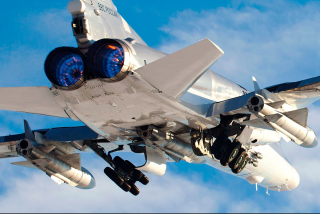Russia Has Reclassified The Tu-22 As A Heavy Bomber (And They Are Heavily Armed)
What does this mean for the New START treaty?
Key point: Obsolete bomber or reborn?
The official reclassification of the Tu-22’s updated models from tactical bombers to heavy, nuclear-capable strategic bomber could lead to a new round of accusations concerning Russia’s potential non-compliance.
In what is the latest sighting of Russia’s most prolific strategic bomber, the Russian Defense Ministry reported earlier this week that two Tu-22M3’s conducted a patrol mission over the Black Sea. According to their press release, "Two Tu-22M3 long-range bombers performed a scheduled flight in the airspace over international waters in the Black Sea.”
Zvezda, the official television channel of the Russian Defense Ministry, has published a brief clip of the occasion. The footage begins with several close-up shots of pilots undergoing final preparations from inside the cockpit, before capturing a multi-angle view of the take-off. The latter part of the video depicts the two Tu-22M3’s cruising side by side.
The Tu-22M3’s covered a distance of approximately 4,500 kilometers over the span of five hours. It would not have needed to refuel while deployed, as it boasts a maximum range of 6,800 kilometers.
Currently serving as the staple strategic strike bomber of the Russian Aerospace Forces (VKS), the Tu-22M3 (NATO reporting name Backfire-C) is a slight iteration of the long-lived Soviet Tu-22M. The Tu-22M3 retains the design philosophy of its predecessor, boasting an upgraded NK-25 engine and minor nose alterations.
The Backfire-C houses the newer, inertially-guided Kh-32 anti-ship missiles that are designed to also be effective against land-based enemy infrastructure. But the star of the Tu-22M3’s armament suite is the Kh-47 Kinzhal (“dagger”), a nuclear-capable ballistic missile with a purported effective range of up to 3,000 kilometers.
Introduced in 1983, the M3 has remained the latest Tu-22 model in the aftermath of the Soviet collapse. while the Russian military is satisfied with the M3’s basic design and core performance features, they recognize that it’s rapidly being rendered obsolete in the age of modern electronic warfare. Their solution is the upcoming Tu-22M3M, which features an “absolutely new avionics system” consisting of GLONASS navigation system integration, a digital onboard interface, and electronic warfare countermeasures (ECM).
From the Arctic region to the Pacific ocean, long-distance patrol missions are a common activity for the VKS. But what’s interesting about this particular flight is the language that Russian media outlets used to describe it. The original TASS headline and all subsequent reprints feature some variation of the insistence that, “all flights are performed in strict compliance with international rules for the use of airspace.”
But why stress the legality of a routine black sea mission? Part of the answer surely lies in the fact that the bombers flew somewhat near to the Ukrainian coast, but there is a deeper factor at play: the Tu-22M stands at the epicenter of an ongoing dispute over Russia’s compliance with the 2010 New START Treaty. Some analysts have speculated that the M3M’s alleged improvements-- specifically, aerial refueling combined with an ability to deploy long-range, nuclear-capable Kh-102 cruise missiles-- place it in the legal category of “undeclared heavy bomber” under New START’s classification system. The official reclassification of the Tu-22’s updated models from tactical bombers to heavy, nuclear-capable strategic bomber could lead to a new round of accusations concerning Russia’s potential non-compliance.
Meanwhile, the M3’s Kh-47 Kinzhal definitely does not constitute a New START violation because the treaty only applies to cruise missiles. The Kremlin, for their part, stridently denies that either the M3 or its upcoming M3M successor have run afoul of any current arms control agreements.
Mark Episkopos is a frequent contributor to The National Interest and serves as research assistant at the Center for the National Interest. Mark is also a PhD student in History at American University. This first appeared earlier last year. Image: Wikipedia.

